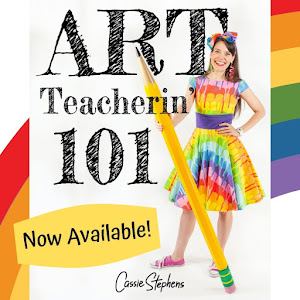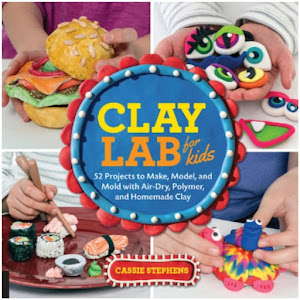Well, after taking a two week hiatus to create our Chinese-inspired clay dragons (which I'll share with ya as soon as those bad boys are glazed and refired), my artists in third grade land returned to their Ming vase projects and finished 'er off. They were pretty stinkin' proud of themselves and who can blame 'em? They're just about as colorful and amazing as my third graders themselves.
This project, like so many of the ones we do, was a million step process that schooled us on bunches of stuff. Here's how we began this adventure:
Day #1/2 (two 30 minute class periods): We reviewed properly painting with watercolor paint (for details of that kind of chat, go here) and chatted about warm vs. cool colors. The kids were given the choice of painting with either color family. We also chatted about what constitutes an abstract painting (that'd be line, color and shape) and how we might begin that kind of painting. With that, the kids set to work on their 9" X 12" papers.
Day #3/4: Although the kids were painting a Ming-vase inspired kind of design, I wanted to emphasize to 'em that their vase could simply be decorative or tell a story. So I shared with them the Legend of Blue Willow. I'm kinda dorky (duh, like I have to tell you that) in that I really love story telling. So I got all into it in hopes that it would inspire some super vase illustrations.
After story time, we chatted about what kind of vase or planter shape they might want. Turns out that there are many different Chinese vase shapes that span the history of pottery in China with each signifying a different period in time. The kids learned to fold their papers in half, draw a shape of their choice and cut. Viola! Instant symmetrical vase!
Once that was complete, the kids created their design on their vase. Pencil lines were traced in blue sharpie and color was added with colored pencils.
Day #5/6: Well...I noticed that when the kids chose to use the cool colors for their backgrounds, their vases blended in. Oops. So to remedy that, and to create a three-dimensional feel to their work, I had the kids create a shadow behind their vase. This was super simple and the kids thought it was like magic. They simply traced their vase onto black paper, cut it out and glued it to the back of their vase, shifting it slightly to cast a shadow. Once the shadow was glued down, the entire thing was adhered to the background paper.
From there, we had a discussion about bonsai and cherry blossom trees. On newsprint, I showed the kids some ideas on how to paint these kinds of trees. I suggested (em, strongly) that they attempt to paint both kinds of trees on practice paper (that'd be newsprint) before painting on their masterpiece.
I am seriously loving both of the backgrounds in these paintings. By the way, when it comes to watercolor paint in the art room, you must use Crayola's Mixing Colors paint. Not the regular Crayola watercolor. This stuff is way better. Look for the box that says "Mixing Colors." It does come with an odd assortment of colors so you might have to supplement with additional pans. But, look at that magenta and turquoise! So pretty!
I love that this artist remembered from our clay lesson that Chinese dragons are often shown with a pearl that is believed to be the source of their strength and power.
Look out that painting on the right seems to have an almost patterned shadow behind the vase. These third graders are, like, genius.
Day #7: Once their tree of choice was painted into their vase, I gave the kids several choices for finishing off their still life. One was using a variety of green paint and a stubby brush to create a leaf texture for their tree.
Another was using tissue squares to create three dimensional blossoms. I remember doing this in elementary school and thinking it was the best thing ever. You simply wrap a piece of 1" square tissue around the bottom of your pencil, put a touch of glue on it and press/hold it onto your paper. Give it a second, gently lift off and, viola! Blossom! Sometimes, a couple of pieces of tissue were glued together before attaching to the paper.
The final option I gave to the kids was simply painting their blossoms on. I also told them that they could do a combo of all three processes if they wanted.
I'm so happy these masterpieces are complete. It's just a coupla weeks until our school wide art show so I was happy to scratch this project off the list. Now! Onto glazing dragons, writing artist autobiographies, painting our clay stars...sigh. Fingers crossed we get it all completed in time.
Until next time, ya'll, have a great week!























































